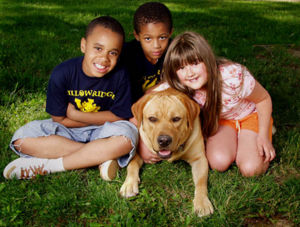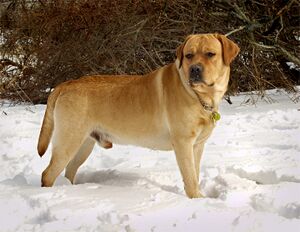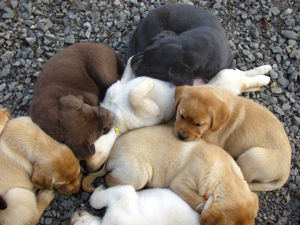Labrador Retriever: Difference between revisions
imported>Nancy Sculerati (→Color) |
imported>Nancy Sculerati |
||
| Line 16: | Line 16: | ||
The [[otter]]-like tail and webbed toes of the Labrador retriever make them excellent swimmers. Their interwoven coat is also relatively waterproof, providing more assistance for swimming. The dogs use their tail as rudders to help them steer while swimming. Their short hair allows them to work in icy waters, where longer-hair retrievers would be dragged down by ice clinging to their coats. | The [[otter]]-like tail and webbed toes of the Labrador retriever make them excellent swimmers. Their interwoven coat is also relatively waterproof, providing more assistance for swimming. The dogs use their tail as rudders to help them steer while swimming. Their short hair allows them to work in icy waters, where longer-hair retrievers would be dragged down by ice clinging to their coats. | ||
====Color==== | |||
[[image:Chocolate_black_yellow_and_fox_red_Lab_pups.jpg|right|thumb|300px|These puppies from two separate litters include all recognized color variations of Labradors, including the "fox red" variety of yellow. Photo by Andrew A. Skolnick]] | |||
There are three officially recognised Lab colors:<ref>The American Kennel Club, ''Labrador Retriever Breed Standard'': "The Labrador Retriever coat colors are black, yellow and chocolate. Any other color or a combination of colors is a disqualification. A small white spot on the chest, called a star, is permissible, but not desirable. White hairs from aging or scarring are not to be misinterpreted as brindling. | |||
Black:-Blacks are all black. A black with brindle markings or a black with tan markings is a disqualification. | |||
Yellow:-Yellows may range in color from fox-red to light cream, with variations in shading on the ears, back, and underparts of the dog. Chocolate:-Chocolates can vary in shade from light to dark chocolate. Chocolate with brindle or tan markings is a disqualification."</ref> black (a solid black color), yellow (anything from light cream to gold to fox-red), and chocolate (medium to dark brown). Puppies of all colors may occur in the same [[litter (animal)|litter]]. The nose of a black or yellow Lab should be black and a chocolate's should be brown, although some fading to pink is permitted. Pink noses without pigmentation is a disqualification. | |||
===Variation in type by country, and, within countries, by club=== | ===Variation in type by country, and, within countries, by club=== | ||
Revision as of 11:35, 3 April 2007
The Labrador retriever is the most popular registered breed of dog in both the United Kingdom and the United States, two of the most "dog-friendly" cultures in the world. What about this breed is likely to account for such outstanding popularity? Labradors are generally both exceptionally friendly, and eager to please, making them excellent companions for children, as well as adults. Their intelligence and size also makes them suitable service animals.
Having been bred first to help Newfoundland fishermen haul in their fishing nets and then in Great Britain as 'gun dogs' for hunting waterfowl, Labs are powerful swimmers who love the water. As much as most Labs take to swimming, life on dry land also suits them - as long as there is an opportunity for some exercise. Their ability to adapt to both city and country life is one more factor that accounts for their popularity (ref:SPORTING GROUP: Labrador RetrieversFaith Hyndman. AKC Gazette. New York: Jul 2006. Vol. 123, Iss. 7; p. 51)
History
It is thought to have descended over time from the St. John's Water Dog (no longer in existence), a crossbreed of native water dogs and the Newfoundland dog (to which the Labrador is closely related), through ad-hoc breedings by early settlers in the 17th century.[1]
Breed standards
Common characteristics round the world
Their coats are short and smooth, and they possess a thick, powerful tail that superficially resembles the tail of an otter. The "otter tail" of the Lab is used in swimming and is a characteristic that is specifically selected for in breeding. Other characteristics that are helpful for water retrieving are the dog's water resistant coat and webbed toes.
The otter-like tail and webbed toes of the Labrador retriever make them excellent swimmers. Their interwoven coat is also relatively waterproof, providing more assistance for swimming. The dogs use their tail as rudders to help them steer while swimming. Their short hair allows them to work in icy waters, where longer-hair retrievers would be dragged down by ice clinging to their coats.
Color
There are three officially recognised Lab colors:[2] black (a solid black color), yellow (anything from light cream to gold to fox-red), and chocolate (medium to dark brown). Puppies of all colors may occur in the same litter. The nose of a black or yellow Lab should be black and a chocolate's should be brown, although some fading to pink is permitted. Pink noses without pigmentation is a disqualification.
Variation in type by country, and, within countries, by club
====Show dogs (conformation shows)
Field dogs (sporting clubs)
Differences in the physical build of the dog have arisen as a result of specialized breeding. Dogs bred for hunting and field-trial work are selected first for working ability, whereas dogs bred to compete for conformation shows are selected for their closeness to the written breed standard.
There are significant differences between the American field and British show lines. In general, show-bred Labs are heavier, shorter-bodied, with thicker coat and tail. Field Labs are generally longer legged, lighter, and more lithe. In the head, show labs generally have broader heads, better defined stops, and thicker, more powerful necks, while field Labs have somewhat narrower heads with longer muzzles.[3] [4] [5] Field-bred Labs are commonly more energetic and high-strung compared with show-bred Labs. As as a consequence, they may be better suited to working relationships than being just a family pet. [3] [4] [5] Of course, each individual dog differs. Some breeders, especially those specializing in the field type, feel that breed shows do not adequately recognize their type of dog. Talk of officially splitting the breed is also sometimes supported. [6]
Lab nose and skin pigmentation
Labrador Retriever. The nose and lips are pink or flesh-colored, the defining aspect of Dudley pigmentation, as compared to the more standard brown or black. Because Lab coloration is controlled by multiple genes, it is possible for recessive genes to emerge some generations later and also there can sometimes be unexpected pigmentation effects to different parts of the body. Pigmentation effects appear in regard to yellow labs, and sometimes chocolate, and hence the majority of this section covers pigmentation within the yellow Lab. The most common places where pigmentation is visible are the nose, lips, gums, feet, and the rims of the eyes, which may be black, brown, light yellow-brown ("liver", caused by having two genes for chocolate),[7] or several other colors. A Lab can carry genes for a different color, for example a black Lab can carry recessive chocolate and yellow genes, and a yellow Lab can carry recessive genes for the other two colors. DNA testing can reveal some aspects of these.
Less common pigmentations (other than pink) are a fault, not a disqualification, and hence such dogs are still permitted to be shown.[7]
The intensity of black pigment on yellow Labs is controlled be a separate gene independent of the fur coloring.[7] Yellow Labs usually have black noses, which gradually turn pink with age (called "snow nose" or "winter nose"). This is due to a reduction in the enzyme tyrosinase which indirectly controls the production of melanin, a dark coloring. Tyrosinase is temperature dependent - hence light coloration can be seasonal, due to cold weather - and is less produced with increasing age (2 years old onwards). As a result, the nose color of most yellow Labs becomes a somewhat pink shade as they grow older.[8] [7]
"Dudley"
A coloration known as "Dudley" is also possible. Dudleys are variously defined as yellow Labs which are unpigmented (pink) (LRC), yellow with liver pigmentation, or "flesh colored" (AKC), rather than having black or brown pigmentation.[7] A yellow Lab with brown or chocolate pigmentation (for example, a brown/chocolate nose), is not a Dudley. Breed standards for Labradors considers a true Dudley to be a disqualifying feature for a show Lab ("Disqualification: A thoroughly pink nose or one lacking in any pigment"). True Dudleys are extremely rare.[7] [9][10] (See: Albinoism). Breeding in order to correct pigmentation often lacks dependability. Because color is determined by many genes, some of which are recessive, crossbreeding a pigmentationally non-standard yellow Lab to a black Lab may not correct the problem or prevent future generations carrying the same recessive genes. That said, pigmentation is often not an issue with animal lovers for whom such issues are often unimportant, and only has significance for those involved with showing and breeding.
Temperament
Working labs
Guide dogs for the Blind
Therapy dogs (other)
"Sniffers" for customs and police work
Health and wellbeing
Labrador life expectancy is generally 12 to 13 years[11], and it generally is a healthy breed with relatively few major problems. Notable issues related to health and wellbeing include:
References
- ↑ http://www.heritage.nf.ca/society/settlement.html
- ↑ The American Kennel Club, Labrador Retriever Breed Standard: "The Labrador Retriever coat colors are black, yellow and chocolate. Any other color or a combination of colors is a disqualification. A small white spot on the chest, called a star, is permissible, but not desirable. White hairs from aging or scarring are not to be misinterpreted as brindling. Black:-Blacks are all black. A black with brindle markings or a black with tan markings is a disqualification. Yellow:-Yellows may range in color from fox-red to light cream, with variations in shading on the ears, back, and underparts of the dog. Chocolate:-Chocolates can vary in shade from light to dark chocolate. Chocolate with brindle or tan markings is a disqualification."
- ↑ 3.0 3.1 http://www.labbies.com/history.htm History of the Labrador Retriever. Retrieved on February 5, 2007.
- ↑ 4.0 4.1 http://www.pineycreeklabradors.com/id20.html
- ↑ 5.0 5.1 http://www.woodhavenlabs.com/english-american.html
- ↑ http://www.woodhavenlabs.com/documents/breed_split2.pdf
- ↑ 7.0 7.1 7.2 7.3 7.4 7.5 http://www.woodhavenlabs.com/yellow-pigment.html
- ↑ See this post on justlabradors.com forum, posted July 2006 by WigWag [presumably Sharon Wagner of wigwaglabradors.com, cited elsewhere in this article concerning Labrador coloration]
- ↑ Labrador Retriever Breed Standards Comparison Chart
- ↑ Dog Breed Advice on Dudley Labradors
- ↑ Fogle, Bruce, DVM (2000). The New Encyclopedia of the Dog. Dorling Kindersley. ISBN 0-7894-6130-7.
Further reading
- Cunliffe, Juliette (2004). The Encyclopedia of Dog Breeds. Parragon Publishing. ISBN 0-7525-8276-3.
- Fergus, Charles (2002). Gun Dog Breeds, a Guide to Spaniels, Retrievers, and Pointing Dogs. Guilford, CT: Lyons Press. ISBN 1-58574-618-5.





